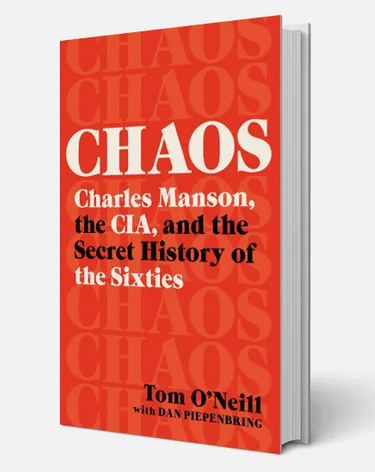CHAOS, Revisited: What Tom O’Neill Actually Proves and What He Doesn’t
Real argument: The official “Helter Skelter” story about the Manson murders is incomplete. Institutions-law enforcement, courts, possibly intelligence-adjacent programs, missed or buried facts that matter. Verdict: Read if you value methodical doubt over closure; borrow if you need courtroom-grade certainty.
BOOKS
11/7/20255 min read


The Big Idea
O’Neill’s thesis is simple and uncomfortable: the canonical Manson narrative-prosecutor Vincent Bugliosi’s Helter Skelter, explains part of the story while sidelining facts that don’t fit. Over a long, often obsessive investigation, O’Neill reconstructs police decisions, prosecutorial tactics, probation misfires, and threads touching 1960s counterculture, drugs, and research programs. He doesn’t claim a single grand conspiracy; he claims systemic opacity. The problem he solves is not “who did it”-we know that- but “why did the system behave so strangely?”
What’s New Here (and Why It Matters)
Plenty of books retell the murders. This one interrogates the record-keeping: sealed reports, non-prosecution of obvious offenses pre-murders, informant status rumors, parole head-scratchers, and witnesses who changed their stories. Its contribution is method, not myth. O’Neill models the forensic audit of a narrative, the habit of treating anomalies as evidence of structural failure. You won’t leave with a new dogma; you’ll leave with a better lie detector.
Core Arguments / Plot Architecture (spoiler-safe)
Set-up: O’Neill stumbles onto an anniversary assignment and discovers too many loose ends to file a feel-good magazine piece.
Middle: He pursues public records, interviews, and legal correspondences; cross-checks official accounts against memos, arrest logs, and testimony.
Throughlines:
The neat Helter Skelter motive competes with messier realities (drug disputes, sex-and-scene economy, law-enforcement missteps).
Recurring institutional leniency toward players later charged with severe crimes.
Period-specific context (e.g., the era’s drug experiments and counterintelligence) as an environment where unusual things had bureaucratic cover.
Close: No “ta-da.” The argument is cumulative: when enough small oddities align, the story you were sold looks curated.
Evidence style: Public records, contradictory interviews, and archival fragments. Lots of triangulation; few smoking guns.
Deep Dive
Frameworks & Models
Anomaly Ledger:
What it is: A running list of facts that don’t fit the official story.
Use it: In any investigation (corporate, legal, journalistic), log each anomaly, source it, and resist premature explanations. Patterns will surface.
Sourcing Map:
What it is: Who says what, based on which document, under what incentive.
Use it: Tag each claim with its provenance (e.g., arrest record vs. memoir vs. recollection decades later). Weight accordingly.
Timeline Compression Test:
What it is: Force-fit every event on a single, granular timeline.
Use it: Many impressive narratives fail when time stamps collide.
Motive Stack:
What it is: Don’t accept single-motive stories in complex human networks.
Use it: Stack motives (drugs, status, fear, profit) and ask which is actually evidenced, not inferred.
Evidence Check
Where it’s strong:
Documentary abrasion: O’Neill excels at showing contradictions between filed reports and public claims.
Institutional patterning: Repeated procedural oddities (lost files, soft responses) form a credible signal of dysfunction or protection.
Where it’s weak:
Inference drift: Sometimes dots are close but not connected by verifiable lines; readers must police their own leaps.
Selective visibility: The archive is incomplete; silence can mean “nothing here” or “missing here.” The book can’t always distinguish the two.
Assumptions Under the Hood
Bureaucracies hide error as reflex, not necessarily as conspiracy.
Contradictions in official narratives are diagnostic, not decorative.
The 1960s milieu-especially drugs and informal informant networks-creates plausible nonlinear paths between subcultures and agencies.
Those assumptions are fair; still, they require restraint. Curiosity isn’t proof.
Practical Takeaways
Build a paper spine. Before debating “why,” stack the “when/where/who” with citations. Most confident opinions collapse under a clean timeline.
Weight sources by incentives. Prosecutors defend verdicts; defendants defend myths; cops defend procedure. Adjust trust accordingly.
Don’t romanticize anomalies—or dismiss them. An anomaly is a lead, not a conclusion. Follow it or file it, but don’t force it.
Distinguish secrecy from privacy. Sealed records protect many things; not all seals signal malfeasance.
Ask cui bono at each revision. When the narrative changes, who gains—politically, reputationally, financially?
Learn FOIA hygiene. Specific requests, date ranges, and named custodians beat vague fishing trips.
Preserve your chain of custody. Screenshots, file hashes, and duplicated archives matter when the other side claims your documents “never existed.”
Contrarian Note
At times, Chaos risks overvaluing the interesting anomaly over the probable explanation. That’s seductive and dangerous. Extraordinary claims demand extraordinary documentation, not just a stack of eyebrow-raisers. Why it matters: readers can leave allergic to any official account- even when the mundane explanation fits the bulk of evidence.
Blind Spots & Risks
Victim eclipse: The structural critique can overshadow the human loss; ethical focus sometimes blurs.
Sampling bias: Interviews skew toward sources willing to talk; those who refuse may be the most relevant.
Era contamination: The 1960s birthed real covert programs. That backdrop can make unrelated coincidences look causal.
Myth marketplace: By pushing against a dominant myth, the book can accidentally seed alternative myths readers treat as settled.
Who Should Read This (and Who Shouldn’t)
Read if:
You study institutions and want a field manual for interrogating official stories.
You’re a true-crime reader who cares more about records than reenactments.
You work in compliance, investigations, or journalism and need better skepticism.
Skip if:
You want a single, definitive alternative motive stamped “solved.”
You dislike slow, document-driven narrative.
You’re sensitive to speculation adjacency; even cautious readers will feel the gravitational pull.
How to Read It
Pacing: Two-to-three chapters at a time; maintain your own notes.
Skim vs. slow down: Skim colorful scene-setting; slow down on footnotes, document excerpts, and conflicting witness accounts.
Format: Print/ebook beats audio; you’ll want to flip and cross-reference.
Companion read: Keep a neutral timeline (Google Sheet) and drop in each claimed date/place- helps separate signal from story.
Scorecard
Originality: 8 - Reframes a cultural monolith by interrogating the paperwork.
Rigor / Craft: 7 - Persistent, sourced, but hampered by gaps no outsider can fully close.
Clarity: 7 - Clear micro-claims; macro-thesis stays intentionally cautious.
Usefulness: 8 - A template for skeptical inquiry beyond this case.
Re-read Value: 7 - Worth revisiting when fresh releases or archives surface.
If You Liked This, Try…
Helter Skelter (Vincent Bugliosi & Curt Gentry): Read the canonical narrative you’re being asked to question—then compare claims and sources.
The Family (Ed Sanders): Earlier investigative counterpoint with underground-press texture; useful for context and drift.
Acid Dreams (Martin A. Lee & Bruce Shlain): The landscape of LSD, policy, and programs that frame the era’s strangeness.
Say Nothing (Patrick Radden Keefe): How to interrogate contested violence with rigor and restraint.
The Coldest Case in Laramie (podcast, NYT): Anomalies + institutional memory + how stories calcify.
FAQs
Is this a conspiracy book?
It’s an investigative skepticism book. It questions institutions and records; it doesn’t present a single master plot.
Does O’Neill prove intelligence involvement?
He surfaces overlaps and oddities; he doesn’t claim courtroom-level proof. Treat those sections as questions that deserve better access to records.
How is this different from Helter Skelter?
Bugliosi argued a unified motive and tidy arc. O’Neill argues for plural causes, messy context, and procedural failures that the tidy arc glosses over.
Is it respectful to the victims?
Mostly, yes—but the focus is on systems and narratives. If you want a victim-centric retelling, supplement with other works.
Will I end with a clear answer?
No. You’ll end with a better toolkit for judging answers.
Final Verdict
Chaos won’t hand you a new grand theory; it hands you a better flashlight. O’Neill’s gift is not revelation but discipline—timeline work, source weighting, and the courage to say “this doesn’t add up” without pretending you can solve it alone. If you want a manual for thinking straight about messy histories, buy. If you crave resolution more than rigor, borrow—and prepare to be annoyed by ambiguity.




